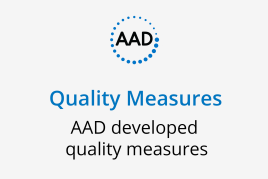SPOT Skin Cancer™: Skin Cancer Check Program

Hosting an AAD skin cancer check event is a great way to demonstrate your commitment and passion to the community and the specialty. The skin cancer check program is the Academy's longest-standing public health program. Since 1985, dermatologists have conducted more than 2.9 million free skin cancer checks and detected more than 293,000 suspicious lesions, including more than 33,700 suspected melanoma.
Host a free skin cancer check event in your area
The AAD provides complimentary forms and skin cancer handouts. Your skin cancer check event will also be advertised on the AAD website and toll-free hotline.
Get free skin cancer check materials
The Academy is working to deliver information and resources state societies need to help advocate for the specialty. Here, you'll find a toolkit full of resources to support the AAD's skin cancer check program.
Skin cancer check resources
Providing skin cancer checks plays an important role in increasing public awareness about skin cancer prevention and detection. In addition to your skin cancer check event, consider conducting a community presentation before or during your event to drive home the message of early detection and prevention. The AAD has many resources you can use to prepare such as quizzes, fact sheets, and other handouts.
Fact sheets: Reinforce your message by leaving behind the AAD's skin cancer fact sheet and indoor tanning fact sheet.
Patient education: Find everything you need to educate your patients about skin conditions.
Skin cancer prevention and detection: Incorporate these tips into your presentation or hand them out at your event.
Additional educational support materials such as pamphlets and bookmarks developed and reviewed by AAD member dermatologists can be purchased through the Academy’s Member Resource Center at (866) 503-7546. Please also access the many AAD free and downloadable educational resources.
Presentation tips
As you prepare your presentation, consider the following tips:
Establish an objective. What is the goal of the presentation and what messages do you want the audience to remember? The goal of a skin cancer detection and prevention presentation, for example, may be to teach the ABCDE's of melanoma and how to perform a self-examination.
Know your audience. Learn as much as possible about your audience, how much they know about the topic, their level of understanding and attention span. Plan your presentation accordingly.
Don’t write out (and read) your full presentation. Reading a script is boring and prevents the speaker from interacting with the audience. Use a presentation outline instead of a script.
Personalize and humanize. Make your presentation come alive by telling stories about some of your skin cancer patients.
Keep it short. Keep the presentation brief (10-15 minutes) and allow time for questions from your audience.
Use visuals. If possible, use charts or graphs to help make your point.
Leave materials behind. Reinforce your messages by leaving the skin cancer brochures, bookmarks, fact sheets, and other materials with your audience.
Practice. Become familiar with the material and then practice in front of a mirror, video camera, or with a family member or friend who can offer constructive criticism.
FAQs
Below are frequently asked questions about the program. If you have additional questions, contact screenings@aad.org.
What is the difference between a public and private skin cancer check?
Private skin cancer checks are usually conducted for a specific organization and are only offered to internal employees. Public skin cancer checks are offered to the general community with no restrictions on who can attend. The Academy promotes public skin cancer checks, but does not promote private events.
Who can assist at the skin cancer check?
Medical personnel, including well-trained physician assistants and nurse practitioners, can screen under the direct supervision of a dermatologist. However, an Academy member MUST serve as the skin cancer check director and be in attendance at the event.
How does the AAD promote the skin cancer check event?
For public skin cancer checks, the Academy will post details about the event on its web site and toll-free number, including a contact’s phone number to make an appointment, get directions, or ask questions. Visitors looking for a free skin cancer check in their area can enter their zip code to find a skin cancer check within a 50-mile radius.
When do most free skin cancer checks take place?
Many skin cancer checks are held between May-August. However, they can take place at any time during the year. The Academy reminds the public of the importance of year-round sun protection, so hosting a skin cancer check in the winter months is appropriate.
How do I order supplies for a skin cancer check?
Order free materials from the Academy here.
Included in the skin cancer check toolkit are:
AAD skin cancer check guidelines booklet
Skin cancer check forms
Skin cancer handouts
Posters
How should the skin cancer check room be set up?
Each exam room should include a table or two chairs, exam gowns, latex gloves or hand sanitizer, and additional lighting, if needed.
How long do I keep my physician copy (“white” copies) of the patient forms?
The patient forms are considered a patient record. Therefore, the forms should be kept by the skin cancer check volunteer for six years or per his/her state’s requirements. If the skin cancer check is coordinated by a large medical facility, the facility may require that it maintain the records.
Why is it important to send the AAD copy (“pink” copies) of the skin cancer check forms and Volunteer Form (“goldenrod”) back to the AAD?
Both records are extremely important to send back to the Academy using the envelope because the skin cancer check form data is tabulated for the program’s annual report and also cumulative report. The data collected is useful in knowing the age ranges of the individuals seeking a skin cancer check, gender, race, family history of skin cancer, as well as recording any presumptive diagnosis.
From the Participating Volunteer Form, the Academy issues thank you letters and certificates of appreciation to the volunteers.
Where are most skin cancer checks held?
Anywhere! Offices, fairs, beaches, hospitals, etc.
How many volunteers are needed for the skin cancer check?
Invite as many local dermatologists and their staff (residents, nurse practitioners, and physician’s assistants) as possible. Assign time slots for those individuals who agree to screen. Note the following suggestions:
One dermatologist can usually screen between 6-10 patients an hour
Have female and male assistants available if a chaperone is requested
Recruit assistants to help with paper work and traffic flow
 Find a Dermatologist
Find a Dermatologist
 Member directory
Member directory
 AAD Learning Center
AAD Learning Center
 2025 AAD Innovation Academy
2025 AAD Innovation Academy
 Need coding help?
Need coding help?
 Reduce burdens
Reduce burdens
 Clinical guidelines
Clinical guidelines
 Why use AAD measures?
Why use AAD measures?
 Latest news
Latest news
 New insights
New insights
 Physician wellness
Physician wellness
 Joining or selling a practice?
Joining or selling a practice?
 Promote the specialty
Promote the specialty
 Advocacy priorities
Advocacy priorities
